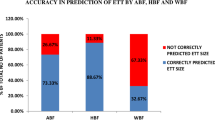Abstract
Purpose. Age-based formulae have been widely used to predict the appropriate size of the endotracheal tube (ETT) in children. These formulae are based on old data from Western countries. The current study was undertaken to assess the effectiveness of these formulae in Japanese children.
Methods. We reviewed data for the past 5 years from children (0–8 years of age) intubated orally with the regular uncuffed ETT or RAE type. The data included the child's age in years and months and the internal diameter (ID) of the ETT.
Results. Data from 1301 children were reviewed. The IDs of the most frequently used ETT were 3.0 mm for patients less than 1 month old, 3.5 mm for those 1 to 4 months old, 4.0 mm for those 5 to 17 months old, and 4.5 mm for those 18 to 23 months old. In children 2 to 8 years old, the ID of the most frequently used ETT was in accordance with the ID predicted by the formula ID (mm) = [age in years + 16]/4. However, the ID predicted by this formula applied to only 53.5% of our patients.
Conclusion. The age-based formula, ID (mm) = [age in years + 16]/4, is applicable to Japanese children. However, we recommend that three sizes be available before endotracheal intubation.
Similar content being viewed by others
Author information
Authors and Affiliations
Additional information
Received: October 13, 2000 / Accepted: March 7, 2001
About this article
Cite this article
Takita, K., Morimoto, Y., Okamura, A. et al. Do age-based formulae predict the appropriate endotracheal tube sizes in Japanese children?. J Anesth 15, 145–148 (2001). https://doi.org/10.1007/s005400170016
Issue Date:
DOI: https://doi.org/10.1007/s005400170016




